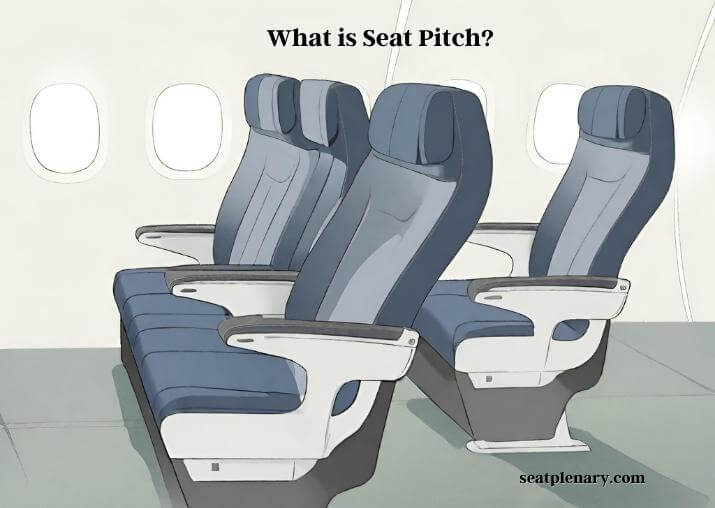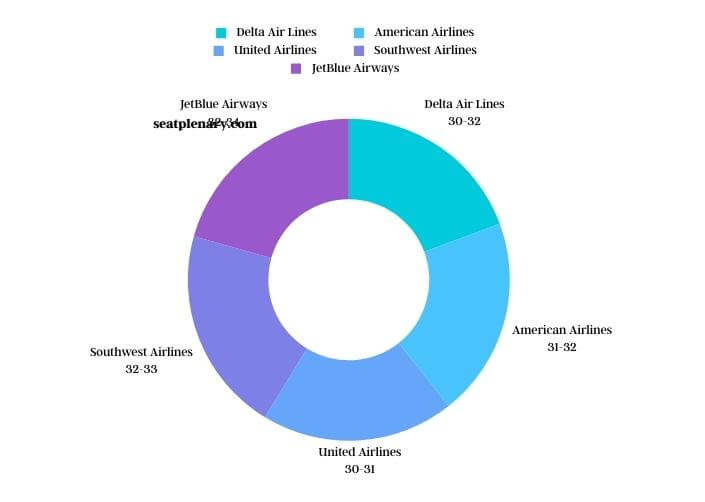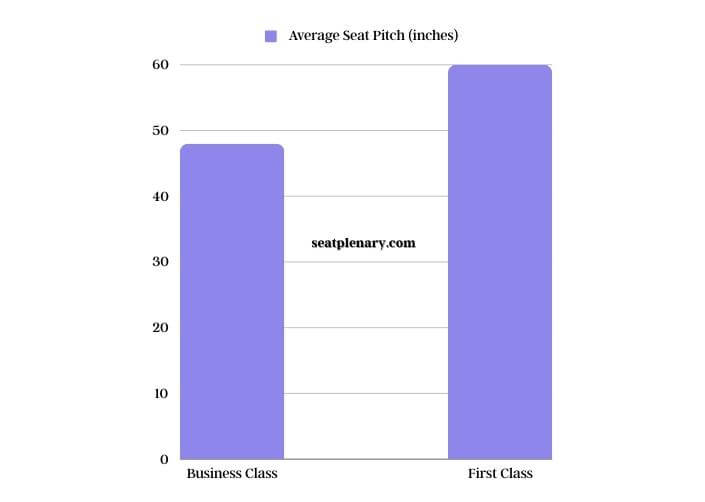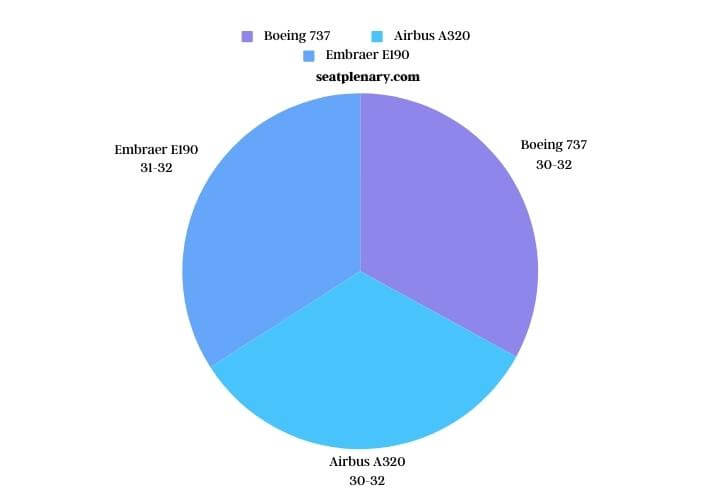Seat pitch is a term used in the airline industry to describe the distance between a point on one seat and the same point on the seat in front of it. This measurement is a key factor in determining the amount of legroom a passenger has.
In the context of air travel, seat pitch is a critical aspect that impacts passenger comfort. It varies significantly among different airlines and types of aircraft. Generally, a higher seat pitch indicates more legroom, which is particularly desirable on longer flights. For example, a 32-inch seat pitch offers a moderate amount of space, commonly found in economy class seating. On the other hand, a seat pitch of 31 inches or less might feel more cramped, especially for taller passengers.

The measurement of seat pitch is straightforward. It is the distance from any point on a seat to the exact same point on the seat in front or behind it. This measurement is not to be confused with seat width, which refers to the space available side-to-side on the seat. The seat pitch can vary even within the same aircraft, depending on the airline’s configuration choices. Luxury or business class seats often have a greater seat pitch, providing more comfort and space.
Seat pitch is essential for travelers, especially those who are taller or have longer legs. Knowing the seat pitch can help in making informed decisions when booking flights. For those interested in a more detailed exploration of seat pitch and its implications for your travel comfort, we invite you to read the detailed article below.
Seat Pitch in Airline Travel – Essential Insights
Defining Seat Pitch in Airline Travel
Basic Concept and Importance
Let’s kick things off by getting to grips with what seat pitch actually is. Think of it as the legroom in airplanes. It’s the distance from a point on your seat to the same point on the seat in front of you. This little measurement plays a big role in how comfy you are during your flight. More seat pitch? More legroom. It’s that simple. And in the world of cramped flights, a few extra inches can feel like a luxury.
How Seat Pitch Influences Passenger Comfort
You might wonder why seat pitch is such a big deal. Well, it’s all about personal space and comfort. If you’re tall, or on a long flight, every inch counts. A generous seat pitch means you can stretch out a bit more, avoid the dreaded knee-crunch against the seat in front, and maybe even catch some Z’s without contorting into a pretzel. It’s a game-changer for comfort, especially on those longer journeys.
The Process of Measuring Seat Pitch
Standard Techniques for Measurement
Measuring seat pitch is pretty straightforward. Airlines use a standard method where they measure the distance from one point on a seat to the same point on the seat in front or behind it. This could be from the back of the seat, or the edge of the seat cushion. It’s a consistent way to figure out how much room you’re going to get.
Distinction Between Seat Pitch and Seat Width
Now, don’t mix up seat pitch with seat width. They’re two different things. Seat width is the size of the seat itself, side to side. It’s about how much elbow room you have. Seat pitch, on the other hand, is all about the legroom. Both are key to your comfort, but today we’re focusing on those precious inches in front of your knees.
Comparing Seat Pitch Across Different Airlines
Seat Pitch Comparison Among Leading Airlines
| Airline | Economy Class Seat Pitch (inches) |
| Delta Air Lines | 30-32 |
| American Airlines | 31-32 |
| United Airlines | 30-31 |
| Southwest Airlines | 32-33 |
| JetBlue Airways | 32-34 |

This table shows how seat pitch can vary even among major airlines. It’s a key factor to consider when booking your flight.
Factors That Influence Airlines’ Seat Pitch Decisions
Airlines think about a lot of stuff when deciding seat pitch. They’re juggling passenger comfort with how many seats they can fit on a plane. More seats usually mean more money for them. But, they also have to keep us flyers happy enough to come back. It’s a tricky balance between space and economics.
Seat Pitch in Various Travel Classes
Economy Class Seat Pitch Standards
In economy class, space is at a premium. Here, seat pitch is usually tighter – think 30 to 32 inches. It’s the most affordable way to fly, but it also means getting cozy with your limited legroom.
Premium Seating: Business and First-Class Seat Pitch
| Class | Average Seat Pitch (inches) |
| Business Class | 48-60 |
| First Class | 60-80 |

As you move up to business or first class, the seat pitch gets more generous. We’re talking about enough room to stretch out, maybe even lie flat. It’s a whole different world up there in the front of the plane.
Seat Pitch: Long-Haul vs Short-Haul Flights
Comfort Factors in Long-Distance Flights
On long-haul flights, seat pitch becomes super important. You’re in that seat for hours, maybe even a whole day. A few extra inches of seat pitch can be the difference between arriving fresh or stepping off the plane like a zombie.
The Role of Seat Pitch in Shorter Journeys
For short hops, seat pitch might not seem as critical. You’re up and down before you know it. But even then, a cramped seat can make a short trip feel a lot longer. It’s all about starting and ending your journey on a good note.
Selecting the Best Seat for Your Journey
Strategies for Choosing Seats Based on Seat Pitch
Picking the right seat is almost an art form. If legroom is your top priority, check the seat pitch before you book. Some airlines even let you pay a bit extra for seats with more room. It’s worth considering, especially if you’re tall or on a longer flight.
Economy Class Seat Pitch Averages for Different Aircraft Types
| Aircraft Model | Average Seat Pitch (inches) |
| Boeing 737 | 30-32 |
| Airbus A320 | 30-32 |
| Embraer E190 | 31-32 |

Different aircraft models have different space constraints, so the seat pitch can vary. This table gives you a rough idea of what to expect on some common planes.
Frequently Asked Questions (FAQs)
Can Seat Pitch Vary Within the Same Airline?
Yes, seat pitch can vary within the same airline, often significantly. This variation is due to several factors, including the type of aircraft, the cabin layout chosen by the airline, and the class of service. For instance, an airline may operate different versions of the same aircraft model, each with a unique interior configuration.
Within the same cabin, such as economy class, airlines might offer premium economy seats with extra seat pitch. This variability means that two flights with the same airline could offer different levels of comfort and space.
How Does Softex Seats Compare to Other Types of Car Upholstery in Terms of Comfort and Durability?
When it comes to comfort and durability, Softex car upholstery stands out among other types of car upholstery. With its unique composition, Softex seats provide a lush and luxurious feel, surpassing the traditional leather upholstery. Not only does Softex offer exceptional comfort, but it also boasts remarkable durability, enabling it to withstand the daily wear and tear of car usage. In comparison to other options, Softex car upholstery excels in providing a delightful experience for drivers and passengers alike.
Does Seat Pitch Affect Flight Safety?
Seat pitch itself doesn’t directly impact flight safety in terms of aircraft operation. It can affect evacuation speed in an emergency. Regulatory bodies like the Federal Aviation Administration (FAA) require that aircraft must be capable of being evacuated within 90 seconds. While there’s no specific regulation for minimum seat pitch, too little space could theoretically slow down an evacuation. Airlines and aircraft manufacturers must balance passenger comfort with the ability to leave the aircraft swiftly and safely in an emergency.
How Does Seat Pitch Impact Airline Revenue?
Seat pitch directly impacts airline revenue by determining the number of seats that can be fitted into an aircraft. Reducing seat pitch allows airlines to add more seats, potentially increasing revenue per flight.
This strategy must be balanced against passenger comfort and satisfaction. Airlines risk losing customers if they perceive the seating to be too cramped. Therefore, airlines often find a middle ground, offering different seat pitches and pricing tiers to cater to various customer preferences and willingness to pay.
Is Seat Pitch the Same as Legroom?
While seat pitch is closely related to legroom, they are not exactly the same. Seat pitch is a fixed measurement, indicating the space between two points on seats. Legroom, on the other hand, refers to the actual space available for a passenger’s legs and can be affected by other factors like the thickness of the seat back. A seat with a thin back in a high seat pitch configuration might offer more legroom than a thicker seat in the same seat pitch setup.
Can Passengers Modify Seat Pitch During a Flight?
Passengers cannot modify the seat pitch during a flight as it is a fixed measurement determined by the airline’s aircraft configuration. However, passengers can sometimes enhance their personal space by adjusting other seat features, such as reclining their seat back (where permitted) or using footrests. For more significant space adjustments, passengers would need to select different seats or seat classes, such as exit row seats or premium classes, which typically offer more space.
How Do Airlines Decide on Seat Pitch?
Airlines decide on seat pitch based on a combination of factors including customer satisfaction, competitive positioning, and profitability. They consider market research on passenger comfort and preferences, competitive analysis of what other airlines are offering, and financial models to determine how seat pitch affects ticket pricing and overall revenue. Airlines also consider the demographic and typical flight duration of their routes; for instance, longer flights might have more generous seat pitch to ensure passenger comfort.
Does Seat Pitch Differ in Different Countries?
Seat pitch can differ in different countries, primarily due to varying airline strategies and regional market preferences. For example, airlines in regions where price sensitivity is higher might opt for a tighter seat pitch to keep fares low. Conversely, in markets where passengers prioritize comfort, especially on long-haul flights, airlines might offer a more generous seat pitch.
Regulatory environments and cultural expectations in different countries can influence how airlines configure their cabin space.
So, there you have it. Seat pitch is a key part of your flying experience. It’s about more than just legroom; it’s about comfort, especially on longer flights. Each airline and aircraft type offers its own take on space, so it pays to do your homework before you book. Next time you fly, remember: those inches in front of you can make a big difference in how you feel when you land.
